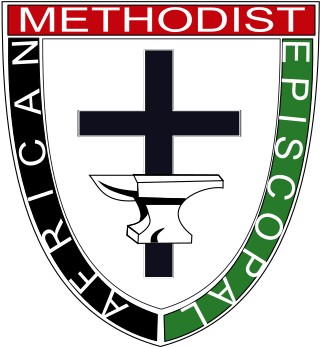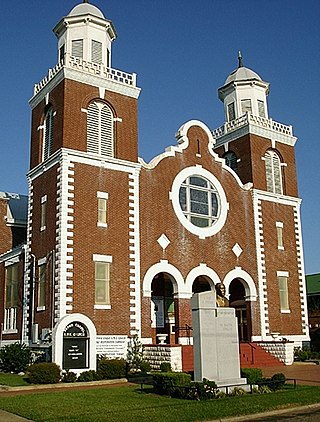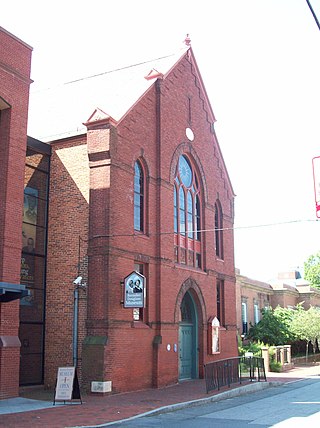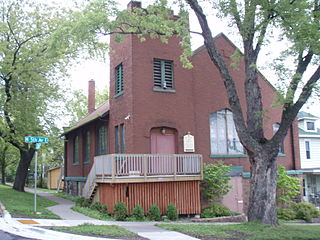The African Union Methodist Protestant Church (AUMPC), abbreviated as A.U.M.P. Church, is a Methodist denomination. It was chartered by Peter Spencer (1782–1843) in Wilmington, Delaware, in 1813 as the "Union Church of Africans", where it became known as the "African Union Church".

The African Methodist Episcopal Church, usually called the AME Church or AME, is a Methodist denomination based in the United States. It adheres to Wesleyan–Arminian theology and has a connexional polity. It cooperates with other Methodist bodies through the World Methodist Council and Wesleyan Holiness Connection.

The Mother Bethel African Methodist Episcopal Church is an historic church and congregation which is located at 419 South 6th Street in Center City Philadelphia, Pennsylvania, USA. The congregation, founded in 1794, is the oldest African Methodist Episcopal congregation in the nation.

The African Methodist Episcopal Zion Church, or the AME Zion Church (AMEZ) is a historically African-American Christian denomination based in the United States. It was officially formed in 1821 in New York City, but operated for a number of years before then. The African Methodist Episcopal Zion Church adheres to Wesleyan-Arminian theology.
Black Methodism in the United States is the Methodist tradition within the Black Church, largely consisting of congregations in the African Methodist Episcopal (AME), African Methodist Episcopal Zion, Christian Methodist Episcopal denominations, as well as those African American congregations in other Methodist denominations, such as the Free Methodist Church.

Brown Chapel A.M.E. Church is a church at 410 Martin Luther King Jr. Boulevard in Selma, Alabama, United States. This church was a starting point for the Selma to Montgomery marches in 1965 and, as the meeting place and offices of the Southern Christian Leadership Conference (SCLC) during the Selma Movement, played a major role in the events that led to the adoption of the Voting Rights Act of 1965. The nation's reaction to Selma's "Bloody Sunday" march is widely credited with making the passage of the Voting Rights Act politically viable in the United States Congress.

The St. Paul A.M.E. Church is a historic American Gothic Revival style African Methodist Episcopal Church located in Raleigh, North Carolina. A red brick and frame structure built in 1884 by black masons, St. Paul's was the first independent congregation of African Americans in Raleigh and is the oldest African-American church in Wake County, North Carolina. Before the end of the Civil War, the future founders of St. Paul's had been slave members of the Edenton Street United Methodist Church. The members of the church began calling their congregation "St. Paul's" in 1848. The church was listed on the National Register of Historic Places in November 1987 and is also a Raleigh Historic Landmark.

The Banneker-Douglass Museum, formerly known as Mt. Moriah African Methodist Episcopal Church, is a historic church at Annapolis, Anne Arundel County, Maryland. It was constructed in 1875 and remodeled in 1896. It is a 2+1⁄2-story, gable-front brick church executed in the Gothic Revival style. It served as the meeting hall for the First African Methodist Episcopal Church, originally formed in the 1790s, for nearly 100 years. It was leased to the Maryland Commission on African-American History and Culture, becoming the state's official museum for African-American history and culture. In 1984, a 2+1⁄2-story addition was added when the building opened as the Banneker-Douglass Museum.
St. Paul A.M.E. Church or Saint Paul's African Methodist Episcopal Church or variations may refer to:

Bethel AME Church, now known as the Central Pennsylvania African American Museum, is a historic African Methodist Episcopal church at 119 North 10th Street in Reading, Berks County, Pennsylvania. It was originally built in 1837, and is a 2½-storey brick and stucco building with a gable roof. It was rebuilt about 1867–1869, and remodeled in 1889. It features a three-storey brick tower with a pyramidal roof topped by a finial. The church is known to have housed fugitive slaves and the congregation was active in the Underground Railroad. The church is now home to a museum dedicated to the history of African Americans in Central Pennsylvania.

Bethel African Methodist Episcopal Church is a historic African Methodist Episcopal Church in Springtown, New Jersey, United States. The church was part of two free negro communities, Othello and Springtown, established by local Quaker families, like the Van Leer Family. The congregation was established in 1810 in Greenwich Township as the African Methodist Society and joined the African Methodist Episcopal Church in 1817. A previous church building was burned down in the 1830s in an arson incident and the current structure was built between 1838 and 1841.

Little Jerusalem AME Church, also known as Bensalem AME Church, is a historic African Methodist Episcopal church located at 1200 Bridgewater Road in Cornwells Heights, Bensalem Township, Bucks County, Pennsylvania. It was built in 1830 and renovated about 1860 and 1896. It is a 1+1⁄2-story, one-room frame structure with a gable roof. The cemetery surrounding the church contains burials of black Civil War soldiers.

St. Paul's Episcopal Church is a historic Episcopal church at Old York and Ashbourne Roads in Elkins Park, Cheltenham Township, Montgomery County, Pennsylvania. It was originally built in 1861, and is a gray stone church in the Gothic style. The church was conceived by noted financier Jay Cooke (1821–1905), along with John W. Thomas, J.F. Peniston and William C. Houston. Its size was doubled with an expansion in 1870, and a 60-foot-tall tower added. A transept was added in 1883, and the two-story parish hall wing in 1891. Architect Horace Trumbauer (1868–1938) made some refinements to the church during the 1897 to 1924 period. The main sanctuary of the church features 13 stained glass windows from Tiffany studios.

St. Paul's African Methodist Episcopal Church is a historic church in Urbana, Ohio, United States. Built in the Greek Revival style in 1876, it is home to a congregation that was founded in the mid-1820s.

The British Methodist Episcopal (BME) Church, Salem Chapel was founded in 1820 by African-American freedom seekers in St. Catharines, Ontario. It is located at 92 Geneva St., in the heart of Old St. Catharines. The church is a valued historical site due to its design, and its important associations with abolitionist activity.

Tindley Temple United Methodist Church, also known as Tindley Temple Methodist Episcopal Church and Calvary United Methodist Church, is a historic Methodist Episcopal church located in the Southwest Center City neighborhood of Philadelphia, Pennsylvania. It was built between 1923 and 1928, and is a large masonry building influenced by the Beaux-Arts Romanesque and Art Deco styles.

St. Mark's African Methodist Episcopal Church is a historic African Methodist Episcopal (AME) church in Duluth, Minnesota, United States. St. Mark's has played a central role in Duluth's African-American community for more than 124 years. While other black organizations have dissolved or moved to the Minneapolis–Saint Paul area, St. Mark's has been a local mainstay.

Mount Zion A.M.E. Church is a historic African American church in Tredyffrin Township, Chester County, Pennsylvania. Built in 1880 and expanded in 1906, Mount Zion was listed on the National Register of Historic Places on January 27, 2015. It was an important community gathering place for African Americans battling racial segregation of local schools in the 1930s.



















